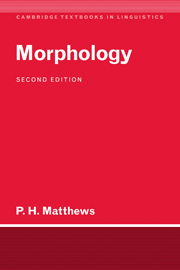Book contents
- Frontmatter
- Contents
- Preface to the first edition
- Preface to the second edition
- Principal references
- 1 What is morphology?
- 2 Word, word-form and lexeme
- 3 Inflections and word-formation
- 4 Lexical derivation
- 5 Compounds
- 6 Morphemes and allomorphs
- 7 Morphological processes
- 8 Morphophonemics
- 9 Properties and their exponents
- 10 Paradigms
- 11 Inflectional morphology and syntax
- 12 Iconicity
- Index
6 - Morphemes and allomorphs
Published online by Cambridge University Press: 05 June 2012
- Frontmatter
- Contents
- Preface to the first edition
- Preface to the second edition
- Principal references
- 1 What is morphology?
- 2 Word, word-form and lexeme
- 3 Inflections and word-formation
- 4 Lexical derivation
- 5 Compounds
- 6 Morphemes and allomorphs
- 7 Morphological processes
- 8 Morphophonemics
- 9 Properties and their exponents
- 10 Paradigms
- 11 Inflectional morphology and syntax
- 12 Iconicity
- Index
Summary
Lexical and inflectional morphemes; words as sequences of morphemes. The morpheme as a syntactic primitive; as a unit of distribution; as ‘same of form and meaning’. Alternations: complementary and contrastive distribution. Morphemes as abstract units; allomorphy.
An agglutinating system. The Noun in Turkish: Case and Plural morphemes. Vowel alternations: Front vs Back; Rounded vs Unrounded; vowel harmony. Possessive and Agentive morphemes. Consonant alternations: ‘soft g’; alternations of voiced and voiceless.
Types of alternation. Recurrent and non-recurrent alternations. Morphemic conditioning, lexical and grammatical. Phonological conditioning: morphemically restricted vs automatic. Alternations of Past Participle in English.
We can now return to inflectional morphology. As we noted in chapter 1, there are alternative models, and in practice different types of language tend to be described differently.
The simplest model is one based on the morpheme. In a line from Yeats which we cited:
And therefore I have sailed the seas and come
both sailed and seas were divided into two units. The first identifies the lexeme, and can be called a lexical morpheme. Following the convention for lexemes established in chapter 2, we can refer to these, in small capitals, as the morphemes sail and sea. The second unit is an inflectional morpheme. In sailed the ending -ed marks Past Participle; let us therefore say, more precisely, that it represents a morpheme ‘Past Participle’. In seas the ending is a Plural marker, and we will accordingly say that it represents the morpheme ‘Plural’. In each word the morphemes form a sequence.
- Type
- Chapter
- Information
- Morphology , pp. 102 - 121Publisher: Cambridge University PressPrint publication year: 1991

